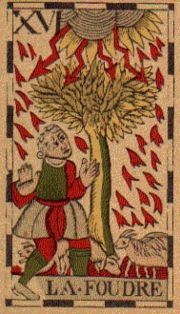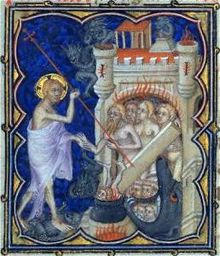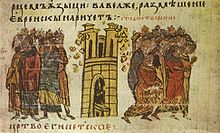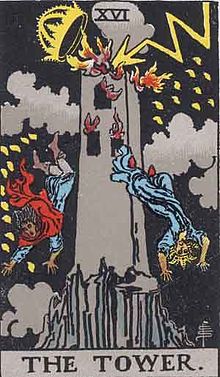The Tower - Tarot card
The Tower (XVI) (most common modern name) is the 16th trump or Major Arcana card in most Italian-suited Tarot decks. It is used in game playing as well as in divination.
History

The Belgian Tarot depicts a tree struck by lightning.
This card follows immediately after The Devil in all Tarots that contain it, and is associated with sudden, disruptive, and potentially destructive change. Some early, painted decks, such as the Visconti-Sforza tarot, do not contain it, and some Tarot variants used for game playing omit it.
Early printed decks that preserve all their cards do feature The Tower. In these decks the card bears a number of different names and designs. In the Minchiate deck, the image usually shown is of two nude or scantily clad people fleeing the open door of what appears to be a burning building. In some Belgian tarots and the 17th century tarot of Jacques Viéville, the card is called La Foudre or La Fouldre, ("The Lightning") and depicts a tree being struck by lightning. In the Tarot of Paris (17th century), the image shown is of the Devil beating his drums, before what appears to be the mouth of Hell; the card still is called La Fouldre. The Tarot of Marseilles merges these two concepts, and depicts a burning tower being struck by lightning or fire from the sky, its top section dislodged and crumbling. Two men are depicted in mid-fall, against a field of multicolored balls. A. E. Waite's version is based on the Marseilles image, with small tongues of fire in the shape of Hebrew yod letters replacing the balls.

In this manuscript picture of the Harrowing of Hell, Jesus forces open the fiery tower gate of Hell to free the virtuous dead from Limbo. The enactment of this scene in liturgical drama may be one source of the image of the Tower.

The destruction of the tower of Babel is depicted in this Bulgarian manuscript.
A variety of explanations for the images on the card have been attempted. For example, it may be a reference to the biblical story of the Tower of Babel, where God destroys a tower built by mankind to reach Heaven. Alternatively, the Harrowing of Hell was a frequent subject in late medieval liturgical drama, and Hell could be depicted as a great gate knocked asunder by Jesus Christ. The Minchiate version of the deck may represent Adam and Eve's expulsion from the Garden of Eden.
Symbolism
The Tower is commonly interpreted as meaning danger, crisis, destruction, and liberation.
Alternate decks
- The Flemish Deck by Vandenborre (c.1750 - 1760) renames it La Foudre ("The Thunderbolt"). It shows a frightened shepherd cowering under a burning tree split by a bolt of lightning while sheep graze at its base.
- In Anne Rice Tarot deck the Tower card depicts Armand in the Vampire Chronicles.
- In X/1999, the Tower is Tokiko Magami & Tooru Shirou.
- In the Mythic Tarot deck, the Tower is depicted with Poseidon.
- In the Golden Dawn system it corresponds to the Hebrew letter Peh, and in the French system it corresponds to Ayin.
In pop culture
- In the SNES video game Ogre Battle: The March of the Black Queen, the Tower is depicted as an ominous-looking tower as lightning bolts strike it during a thunderstorm, yet there are no people jumping out of the tower. On drawing the Tarot card after liberation of one of the towns, it lowers the characters' alignment by 1 or 2 points, and summons an earthquake to damage enemy units when used in battle.
- In JoJo's Bizarre Adventure, a minor antagonist of the third arc of the series called Gray Fly has a Stand called Tower of Gray, an insect-like Stand that Gray Fly uses to kill people on mass transit. It was named after this tarot card, as it is representative of the end of a journey.
- The Tower is a boss monster in The House of the Dead 2, where it is represented by a five-headed hydra (three-headed in The Typing of the Dead). All of the bosses in the House of the Dead series (with the exception of Overkill) are named after cards from the Major Arcana.
- In Shin Megami Tensei: Persona The Tower is represented in Persona 3 by Mutatsu, and in Persona 4 it was represented by Shu Nakajima. It is represented by the personas Chi You and Shiva among others.
- In Harry Potter and the Half-Blood Prince, Divination instructor Professor Trelawney tells Harry that she has seen bad omens regarding "the lightning-struck tower" in her tarot cards. These omens come to fruition in the chapter of the same title, in which Albus Dumbledore falls from the highest tower of Hogwarts castle after his death.
- In episode 184 of the long running and ongoing anime Detective Conan/Case Closed, the television prophet Nagara Haruka predicts an ominous presence within the mansion and shows the Tower card to the cast and audience. Her prediction turns out to be true as murder takes place within the mansion
- In Exorcist: The Beginning, the female lead, Dr. Sarah Novak, (played by Izabella Scorupco) deals out three tarot cards twice in succession. They are La Mort, La Mason Dieu, and Le Diablo which basically spells out what is going on in the plot of the movie. In this instance the tower card is represented by the church that is being unearthed in a place where a church should not be, considering its age to be 5 A.D. and Christianity was not found in that part of Africa at that time according to fallen priest, Father Lancaster Merrin (played by Stellan Skarsgård).
COMMENTS








 The Tower in the 1909
The Tower in the 1909  The Belgian Tarot depicts a tree struck by lightning.
The Belgian Tarot depicts a tree struck by lightning. In this manuscript picture of the Harrowing of Hell, Jesus forces open the fiery tower gate of Hell to free the virtuous dead from Limbo. The enactment of this scene in liturgical drama may be one source of the image of the Tower.
In this manuscript picture of the Harrowing of Hell, Jesus forces open the fiery tower gate of Hell to free the virtuous dead from Limbo. The enactment of this scene in liturgical drama may be one source of the image of the Tower. The destruction of the tower of Babel is depicted in this Bulgarian manuscript.
The destruction of the tower of Babel is depicted in this Bulgarian manuscript.